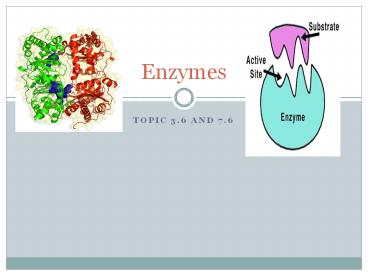Enzymes - PowerPoint PPT Presentation
Title:
Enzymes
Description:
Enzymes TOPIC 3.6 AND 7.6 Enzymes Proteins Biological catalysts May break a substrate molecule down into simpler molecules, or join two or more substrate molecules ... – PowerPoint PPT presentation
Number of Views:580
Avg rating:3.0/5.0
Title: Enzymes
1
Enzymes
- Topic 3.6 and 7.6
2
Enzymes
- Proteins
- Biological catalysts
- May break a substrate molecule down into simpler
molecules, or join two or more substrate
molecules chemically together. - Enzyme itself is unchanged in reaction its used
to speed up the reaction. - Animation- http//highered.mcgraw-hill.com/sites/0
072495855/student_view0/chapter2/animation__how_en
zymes_work.html
3
Activation energy
- Required to enable substrate to change into the
product - 50 chance that the reaction will proceed,
otherwise it goes back to a stable form of the
reactant again.
4
Active site
- Active site
- Part of the enzymes surface into which the
substrate is bound and undergoes and reaction. - Made of different parts of the polypeptide chain
folded in a specific shape. - Specificity the complexity of the binding site
is such that only one type of substrate will
bind.
5
How enzymes work
- Lock and Key model
- Model proposed earlier this century that
suggested that the substrate was simply drawn
into a closely matching cleft on the enzyme
molecule - Induced Fit Model
- more recent studies have revealed that the
process more likely involves an induced fit,
where the enzyme or reactants change their shape
slightly. - reactants bond to enzymes via weak chemical bonds
which weaken bonds within the reactant, allowing
the reaction to proceed more readily
6
Induced Fit Model
- An enzyme fits to its substrate somewhat like a
lock and key. - The shape of the enzyme changes when the
substrate fits into the cleft - (1) The substrate molecules are drawn into the
cleft of the enzyme - (2) The enzyme changes shape, forcing the
substrate molecules to combine - (3) the resulting end product is released by the
enzyme which returns to its normal shape, ready
to receive more.
7
Animation- http//www.sumanasinc.com/webcontent/an
imations/content/enzymes/enzymes.html
8
Catalysts
- Catalysts speed up reactions by influencing the
stability of bonds in the reactants - May also provide an alternative reaction pathway,
lowering the activation energy. - The presence of an enzyme simply makes it easier
for a reaction to take place.
9
Catabolic Reactions
- Some enzymes can cause a single substrate
molecule to be drawn into the active site. - Chemical bonds are broken, causing the substrate
molecule to break apart to become two separate
molecules. - Example digestion, cellular respiration
10
Anabolic Reactions
- Some enzymes can cause two substrate molecules to
be drawn into the active site. - Chemical bonds are formed, causing the two
substrate molecules to form bonds and become a
single molecule - Examples protein synthesis, photosynthesis
11
Enzyme Reaction Rates
- Enzymes are sensitive molecules.
- Often have narrow range of conditions under which
they operate properly. - Temperature
- At low temperatures, there is little activity. As
temperature increases until the point is reached
when the temperature is so high it damages the
protein (denaturation). This causes the enzyme to
stop working.
12
(No Transcript)
13
Enzyme Reaction Rates
- Poisons can cause enzymes to cease functioning
- Cofactors such as vitamins and trace elements are
required for many enzyme to function - pH
- Extremes in acidity (pH) can also cause the
protein structure of enzymes to denature.
14
Enzyme Cofactors
- Cofactors
- Enhance enzyme activity
- Nonprotein component of an enzyme and may be
organic molecules (coenzymes) or inorganic ions
(Ca2, Zn2)
15
Enzyme Inhibitors
- May also be deactivated, temporarily or
permanently, via inhibitors. - Reversible inhibitors
- Used to control enzyme activity
- Often an interaction between the substrate or end
product and the enzymes controlling the reaction. - Build up of the end product or a lack of
substrate may serve to deactivate the enzyme. - May be competitive, noncompetitive, or allosteric
inhibitor
16
Enzyme Inhibitors
- Competitive inhibition
- Enzyme deactivation may be result of competitive
inhibitor blocking the active site. - Noncompetitive inhibition
- Enzyme deactivation may be results of
noncompetitive inhibitor binding to another site
on the enzyme. - Substrate can still bind to active site, but
slows the speed of reaction
17
(No Transcript)
18
Enzyme inhibitors
- Allosteric inhibitors
- Noncompetitive inhibitor binds to enzyme in
another site other than active site, which causes
the active site to be distorted. The substrate
cannot bind to the active site.
19
Enzyme Inhibitors
- Irreversible Inhibitors
- Poisons
- Certain heavy metals bind tightly and permanently
to the active sites of enzymes, destroying their
catalytic properties. - Examples Cadmium (Cd), lead (Pb), mercury (Hg),
and arsenic (As) - Generally non-competitive inhibitors, except Hg
- Heavy metals are retained in the body, and lost
slowly.































